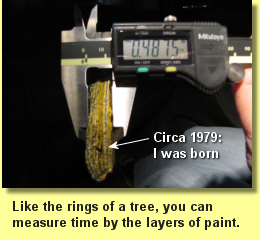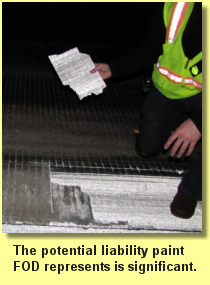|
Back to Webletter
Everything Is Thicker In Texas
By Mike Speidel
Dallas-Fort Worth International Airport (DFW) recently provided Sightline's on-site training workshop for about 30 of its
Maintenance, Operations, and Inspection personnel. From specification development to quality control during application, they learned what to do,
what not to do, and how to sustain its massive marking system. It became the fourth of the "Top 5" airports in the U.S. to have followed-up an
Airfield Marking Audit with Training for its personnel. While we believe every airport is different, I can't help but notice some direct
correlations among the marking programs at ATL, LAX, DFW, and DEN:
The Way It Had Always Been Done
The "strategy" behind maintaining these marking systems in the past was to paint as much as possible regardless of need when
time/weather allowed. This blanket strategy stemmed from the inability to define when a marking was broken, largely due to the lack of objective
criteria for marking effectiveness. Painting everything covered up the good and the bad; often right before a looming FAA Part 139 safety
inspection. Is this sounding familiar?
Thick and Tired
 Painting over old paint without first preparing the surface and/or removing the paint leads to really thick lines and adhesion
issues. Among the Top 5 airports, DFW owned the thickest marking, weighing in at 487.5 mils... That's equivalent to 50 consecutive paint
applications; everything is thicker in Texas! However, during Airfield Marking Audits, we identified significant paint build-up issues at each
large airport. Since the results of the audits, DEN and LAX have undergone large-scale removal operations, and ATL and DFW are in the process of
remediation. In all cases, the huge expense associated with removing thick markings is the result of poor maintenance practices: they painted
themselves into a corner.
Painting over old paint without first preparing the surface and/or removing the paint leads to really thick lines and adhesion
issues. Among the Top 5 airports, DFW owned the thickest marking, weighing in at 487.5 mils... That's equivalent to 50 consecutive paint
applications; everything is thicker in Texas! However, during Airfield Marking Audits, we identified significant paint build-up issues at each
large airport. Since the results of the audits, DEN and LAX have undergone large-scale removal operations, and ATL and DFW are in the process of
remediation. In all cases, the huge expense associated with removing thick markings is the result of poor maintenance practices: they painted
themselves into a corner.
Sustainability
 Needless to say, every airport wants to avoid having to go through this lengthy, costly process in the future. With our help,
ATL, LAX, DFW, and DEN are now making educated decisions toward achieving sustainable marking systems. Based on our recommendations, three of
these airports have purchased their own ultrahigh waterblasters to satisfy surface preparation and paint/rubber removal requirements. One has
already conducted a follow-up audit to establish a new standard to act as a baseline for marking performance. Although these four airports have
different approaches, they share a common goal: adopting a sustainable strategy for future maintenance of the marking system.
Needless to say, every airport wants to avoid having to go through this lengthy, costly process in the future. With our help,
ATL, LAX, DFW, and DEN are now making educated decisions toward achieving sustainable marking systems. Based on our recommendations, three of
these airports have purchased their own ultrahigh waterblasters to satisfy surface preparation and paint/rubber removal requirements. One has
already conducted a follow-up audit to establish a new standard to act as a baseline for marking performance. Although these four airports have
different approaches, they share a common goal: adopting a sustainable strategy for future maintenance of the marking system.
Sustainability is an ongoing process, not an event. Once the markings are identified and considered more than "incidental", a
program towards sustainable maintenance can begin to take shape. Your paint problems have Sightline solutions:
Start here.
Back to Webletter
|



 Painting over old paint without first preparing the surface and/or removing the paint leads to really thick lines and adhesion
issues. Among the Top 5 airports, DFW owned the thickest marking, weighing in at 487.5 mils... That's equivalent to 50 consecutive paint
applications; everything is thicker in Texas! However, during Airfield Marking Audits, we identified significant paint build-up issues at each
large airport. Since the results of the audits, DEN and LAX have undergone large-scale removal operations, and ATL and DFW are in the process of
remediation. In all cases, the huge expense associated with removing thick markings is the result of poor maintenance practices: they painted
themselves into a corner.
Painting over old paint without first preparing the surface and/or removing the paint leads to really thick lines and adhesion
issues. Among the Top 5 airports, DFW owned the thickest marking, weighing in at 487.5 mils... That's equivalent to 50 consecutive paint
applications; everything is thicker in Texas! However, during Airfield Marking Audits, we identified significant paint build-up issues at each
large airport. Since the results of the audits, DEN and LAX have undergone large-scale removal operations, and ATL and DFW are in the process of
remediation. In all cases, the huge expense associated with removing thick markings is the result of poor maintenance practices: they painted
themselves into a corner.
 Needless to say, every airport wants to avoid having to go through this lengthy, costly process in the future. With our help,
ATL, LAX, DFW, and DEN are now making educated decisions toward achieving sustainable marking systems. Based on our recommendations, three of
these airports have purchased their own ultrahigh waterblasters to satisfy surface preparation and paint/rubber removal requirements. One has
already conducted a follow-up audit to establish a new standard to act as a baseline for marking performance. Although these four airports have
different approaches, they share a common goal: adopting a sustainable strategy for future maintenance of the marking system.
Needless to say, every airport wants to avoid having to go through this lengthy, costly process in the future. With our help,
ATL, LAX, DFW, and DEN are now making educated decisions toward achieving sustainable marking systems. Based on our recommendations, three of
these airports have purchased their own ultrahigh waterblasters to satisfy surface preparation and paint/rubber removal requirements. One has
already conducted a follow-up audit to establish a new standard to act as a baseline for marking performance. Although these four airports have
different approaches, they share a common goal: adopting a sustainable strategy for future maintenance of the marking system.